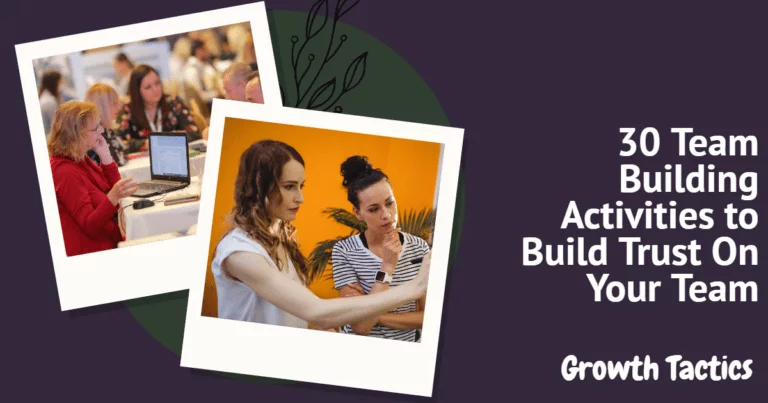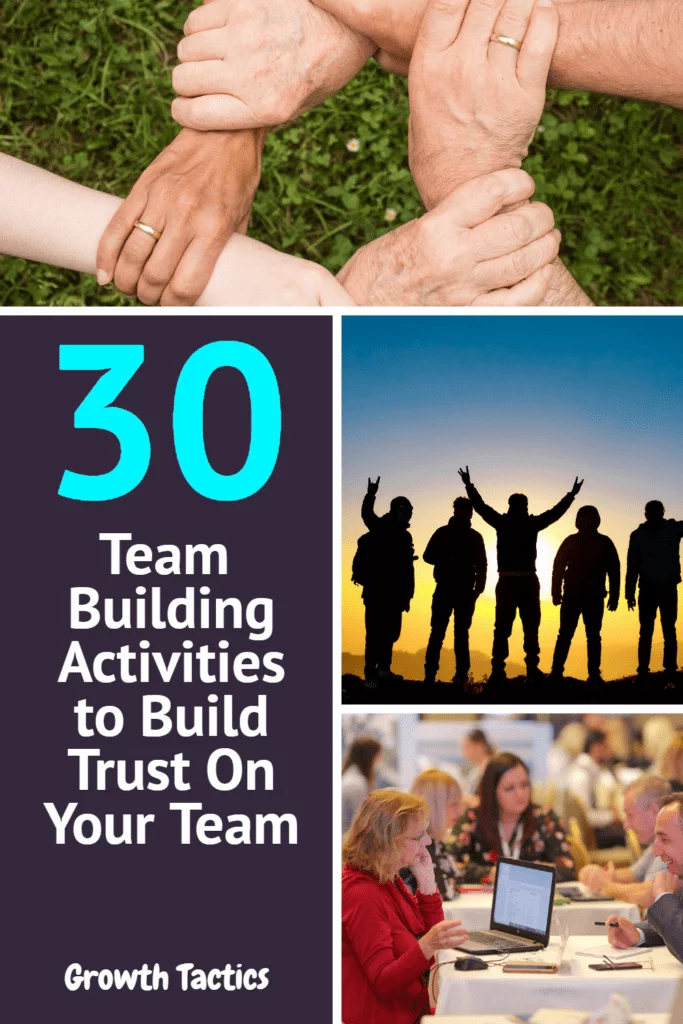Trust is a crucial factor in any successful team. When team members trust each other, they communicate better, collaborate effectively, and achieve their goals more efficiently. Building trust within a team takes time and effort, but it is definitely worth it. In this blog post, we will explore 30 team building activities to build trust among your team members.
Jump To Section
1. Trust Fall
A classic team building activity, the trust fall involves one team member falling backward, trusting their teammates behind them to catch them. This activity requires trust, communication, and a willingness to rely on and support one another.
2. Two Truths and a Lie
Two truths and a lie is a simple but effective icebreaker that encourages team members to share personal information and get to know each other better. Each person shares three statements about themselves, with the others having to guess which statement is false.
3. Blindfolded Obstacle Course
The blindfolded obstacle course is a challenging activity that requires trust and communication. One team member is blindfolded while the rest of the team guides them through the course using verbal instructions. This activity helps build trust and effective communication skills.
4. Group Juggle
Group juggle is a fun activity that requires coordination and trust. Team members stand in a circle and pass juggling balls to each other, gradually increasing the speed and complexity of the throws. This activity helps build teamwork skills and coordination.
5. Human Knot
The human knot is a challenging activity that requires teamwork and collaboration. Team members stand in a circle, reach across and grab hands with two different people, and then work together to untangle themselves without letting go of each other’s hands. This activity helps build trust and problem-solving skills.
6. Minefield
The minefield is another challenging activity that requires trust and teamwork. Team members navigate through an obstacle course blindfolded, relying on their partner’s guidance to avoid obstacles and complete the course. This activity helps build trust and effective communication skills.
7. Puzzle Race
The puzzle race is a fun and competitive activity that requires collaboration and trust. Teams are given different puzzles to solve and must work together to finish the puzzle as quickly as possible. This activity helps build teamwork skills and problem-solving abilities.
8. Trust Walk
The trust walk is a simple activity that requires trust and effective communication. One team member is blindfolded while their partner guides them through an indoor or outdoor course using verbal instructions. This activity helps build trust and effective communication skills.
9. Reverse Scavenger Hunt
The reverse scavenger hunt is a fun activity that requires trust and teamwork. Teams give each other tasks or items to find, rather than looking for items themselves. This activity helps build trust and effective communication skills.
10. Trust Lean
Trust lean is a simple but effective team building activity that requires trust and support. In pairs, one team member stands with their arms folded against a wall while the other leans back, trusting their partner to catch them. This activity helps build trust and support between team members.
11. Egg Drop Challenge:
In this activity, teams design and build a contraption to protect an egg from being dropped from a height. This activity requires creativity, problem-solving skills, and collaboration. It also encourages trust in team members to accomplish a common goal.
12. Truth Circle:
In this activity, team members sit in a circle and take turns sharing something personal, fostering vulnerability and trust in one another. This activity helps break down barriers and encourages open communication and feedback.
13. Trust Drawings:
In this activity, team members pair up and one person is blindfolded while the other guides them to draw a specific object. This activity relies on trust and communication, as the person who is blindfolded must trust their partner’s instructions and use effective communication to complete the drawing.
14. Trust Run:
In pairs, one team member is blindfolded while the other offers guidance and support as they navigate an obstacle course. This activity encourages trust, communication, and teamwork, as partners must work together to complete the course successfully.
15. Birthday Line-Up:
In this activity, team members try to order themselves by birthday without talking, using non-verbal communication and trust in their fellow team members. This activity encourages teamwork and non-verbal communication skills.
16. Trust Sculptures:
In this activity, teams work together to build sculptures out of random materials, relying on trust and collaboration to create a cohesive art piece. This activity encourages creativity, communication, and collaboration.
17. Human Bridge:
In this activity, teams build a bridge using their bodies, requiring trust and coordination to create a stable structure. This activity encourages physical teamwork and trust in one another.
18. Trust Walk Mirror:
In this activity, teammates walk around in pairs and mirror each other’s movements while one person is blindfolded. This activity encourages trust and non-verbal communication skills.
19. Truth Cards:
In this activity, each team member writes a truth about themselves on a card, shuffles the cards, and takes turns reading them out loud. This activity fosters openness and encourages trust among team members.
20. Trust Circle Retrospective:
In this activity, the team sits in a circle and reflects on past successes and failures, discussing lessons learned and building trust through shared experiences. This activity encourages open communication and feedback among team members, as well as trust in one another’s abilities.
21. Escape Room Challenge:
In this activity, teams are immersed in an escape room scenario where they must work together to solve puzzles and challenges within a limited time frame. The activity requires trust, effective communication, problem-solving skills, and collaboration. It promotes teamwork, as team members must rely on each other’s strengths to escape.
22. Trust Balance:
In this activity, team members work in pairs, with one person balancing on a beam while the other provides support and guidance. This activity requires trust, effective communication, and teamwork. The person balancing must trust their partner to provide the necessary support and guidance to prevent them from falling.
23. Blind Drawing Challenge:
In this activity, team members pair up, with one person blindfolded and the other describing a specific object for them to draw. This activity fosters trust, effective communication, and active listening skills. The person who is blindfolded must trust their partner’s instructions and rely on their communication skills to accurately draw the object.
24. Trust Box:
In this activity, team members write down trust-building actions or compliments for each other and place them in a box. Each person then randomly selects a note from the box and shares the message with the team member it is meant for. This activity enhances trust, positivity, and appreciation within the team.
25. Trust Tag:
In this activity, one team member closes their eyes, and another person guides them around, helping them avoid obstacles. This activity fosters trust, effective communication, and reliance on each other. The person who is blindfolded must trust their partner to provide accurate guidance and must effectively communicate their needs and challenges.
26. Group Storytelling:
In this activity, teams take turns adding to a story, building trust and collaboration as they create a cohesive narrative. This activity promotes effective communication, active listening, creativity, and teamwork. Team members must trust each other’s contributions and work together to build an engaging and coherent story.
27. Team Appreciation Circle:
In this activity, team members form a circle and take turns expressing their appreciation for one another. This activity boosts trust, morale, and team spirit. It helps team members feel valued and supported, fostering a positive and supportive team environment.
28. Strengths Sharing:
In this activity, each team member shares their unique strengths and talents with the rest of the team. This activity promotes trust, understanding, and appreciation of each other’s capabilities. It helps team members recognize the value and potential in their teammates, fostering effective collaboration and leveraging each other’s strengths.
29. Trust Dice:
In this activity, each team member rolls a dice and shares a personal experience or answer based on the number rolled. This activity promotes trust and vulnerability, as team members open up about personal experiences. It encourages open communication and creates a safe space for sharing and understanding each other on a deeper level.
30. Trust Challenge:
In this activity, teams are given a challenging task or problem to solve together. This activity requires trust, collaboration, effective communication, and problem-solving skills. It promotes teamwork and encourages team members to trust in each other’s abilities and work together to overcome difficulties and achieve success.
Why Trust is Important on a Team
1. Building Strong Relationships
Trust is essential for building strong relationships within a team. When team members trust each other, they are more likely to work together effectively and collaborate towards achieving shared goals. Trust forms the foundation of positive relationships, fostering a sense of loyalty, mutual respect, and support among team members.
2. Enhancing Communication
Trust plays a vital role in enhancing communication within a team. When team members trust each other, they feel safe to express their thoughts, ideas, and concerns openly. This leads to open and honest communication, where team members can provide constructive feedback, share different perspectives, and engage in meaningful discussions without fear of judgment or repercussions. Trust encourages active listening and creates an environment where everyone’s opinions are valued and considered.
3. Promoting Collaboration
Trust is crucial for promoting collaboration within a team. When team members trust one another, they are more likely to share information, resources, and expertise. They are also more willing to ask for help when needed and offer assistance to others without hesitation. Trust fosters a spirit of cooperation and a willingness to work together towards a common goal, resulting in increased productivity and team success.
4. Increasing Productivity
Trust has a direct impact on team productivity. When team members trust each other, they are more likely to delegate tasks, rely on each other’s abilities, and distribute workload more efficiently. Trust eliminates the need for micromanagement and allows team members to focus on their responsibilities, knowing that their colleagues will deliver on their commitments. This creates a more productive and efficient work environment, where individuals can perform at their best and contribute to the overall success of the team.
5. Fostering Innovation
Trust is also essential for fostering innovation within a team. When team members trust each other, they are more likely to take risks and share creative ideas without fear of criticism or rejection. Trust encourages an environment of psychological safety, where individuals feel comfortable taking chances, exploring new possibilities, and challenging the status quo. This leads to increased innovation and problem-solving capabilities within the team.
6. Strengthening Accountability
Trust strengthens accountability within a team. When team members trust each other, they are more likely to take ownership of their actions and accept responsibility for their outcomes. Trust encourages individuals to be reliable and dependable, knowing that their team members trust them to fulfill their commitments. This promotes a culture of accountability and excellence, where everyone is motivated to perform their best.
7. Nurturing a Positive Culture
Trust is fundamental in nurturing a positive team culture. When team members trust each other, they are more likely to support, uplift, and encourage one another. Trust creates a sense of camaraderie and mutual support, where team members celebrate each other’s successes and offer assistance during challenging times. Trust cultivates a positive and inclusive team culture, where individuals feel valued, respected, and motivated to contribute their best.
In conclusion, trust is an indispensable component of effective teamwork. It serves as the glue that holds a team together, allowing members to build strong relationships, communicate openly, collaborate effectively, and achieve higher levels of productivity and success. Establishing and nurturing trust within a team is essential for creating a positive and high-performing work environment and these trust-building activities can help you get there.


